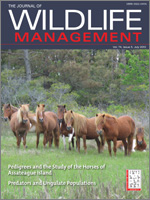To investigate the role of black-backed jackals (Canis mesomelas) as predators, we studied diet, prey selection, and predation impact of jackals on 2 game ranches in South Africa that differed in ungulate diversity and biomass. Results showed that large (>15 kg) ungulate species dominated jackal diets throughout the year on both the less diverse (range of ingested biomass across seasons = 39–78%) and more diverse (26–69%) game ranch. Other important food items included medium-sized mammals (1–3 kg; 1–26%) and fruit (2–69%), whereas small mammals comprised 3–11% of ingested biomass across seasons on both sites. Jackals were not random in consumption of ungulates, and consumption patterns suggested jackals actively hunted certain species rather than consumed them as carrion. During ungulate birthing periods, jackals consumed almost exclusively those ungulate species that were hiders (i.e., fawns were hidden in tall vegetation away from herd) regardless of ungulate densities, suggesting that primarily fawns were preyed upon. Among hiders, there was a negative relationship (P = 0.01) between body size and percent of population consumed by jackals, indicating smaller species were more susceptible than larger species to jackal predation. Consequently, springbok (Antidorcas marsupialis) were always selected over other ungulate species on both sites, and this species was the most impacted by jackal predation. In contrast, ungulate species that were followers (i.e., fawns immediately followed mothers within protection of the herd) were scarcely or not at all consumed by jackals, regardless of body size or density. Medium-sized mammals were selectively consumed over ungulates, and there was a negative relationship (P < 0.01) between consumption of berries and ungulates, indicating alternative food resources influenced consumption of ungulates on our study sites. Our results will help wildlife managers in Africa identify ungulate species susceptible to jackal predation, and can be used to develop management strategies for reducing jackal predation in areas where it is problematic.
How to translate text using browser tools
1 July 2010
Diet, Prey Selection, and Predation Impact of Black-Backed Jackals in South Africa
Unn Klare,
Jan F. Kamler,
Ute Stenkewitz,
David W. Macdonald
ACCESS THE FULL ARTICLE
It is not available for individual sale.
This article is only available to subscribers.
It is not available for individual sale.
It is not available for individual sale.

Journal of Wildlife Management
Vol. 74 • No. 5
July 2010
Vol. 74 • No. 5
July 2010
Antidorcas marsupialis
black-backed jackal
Canis mesomelas
diet
game ranch
predation
scat analysis




